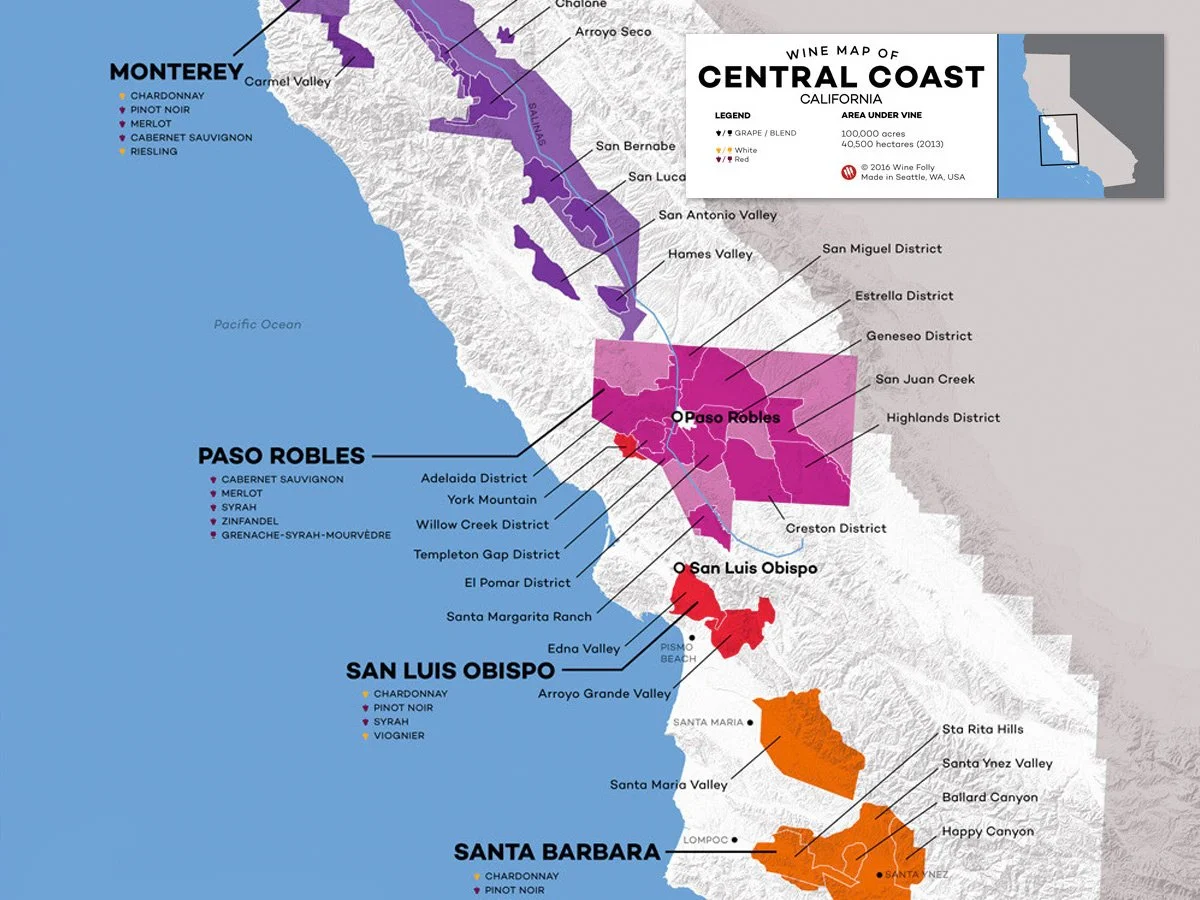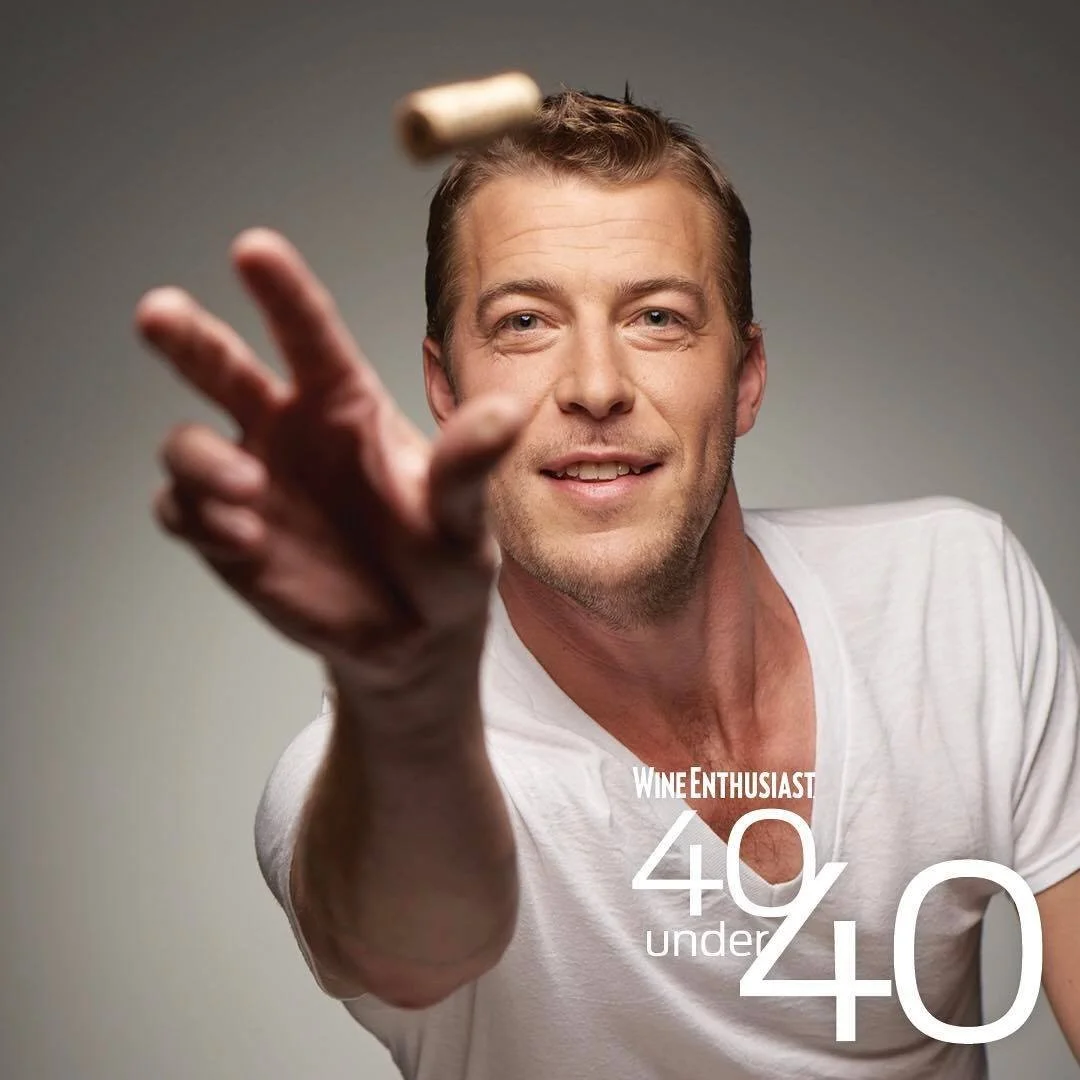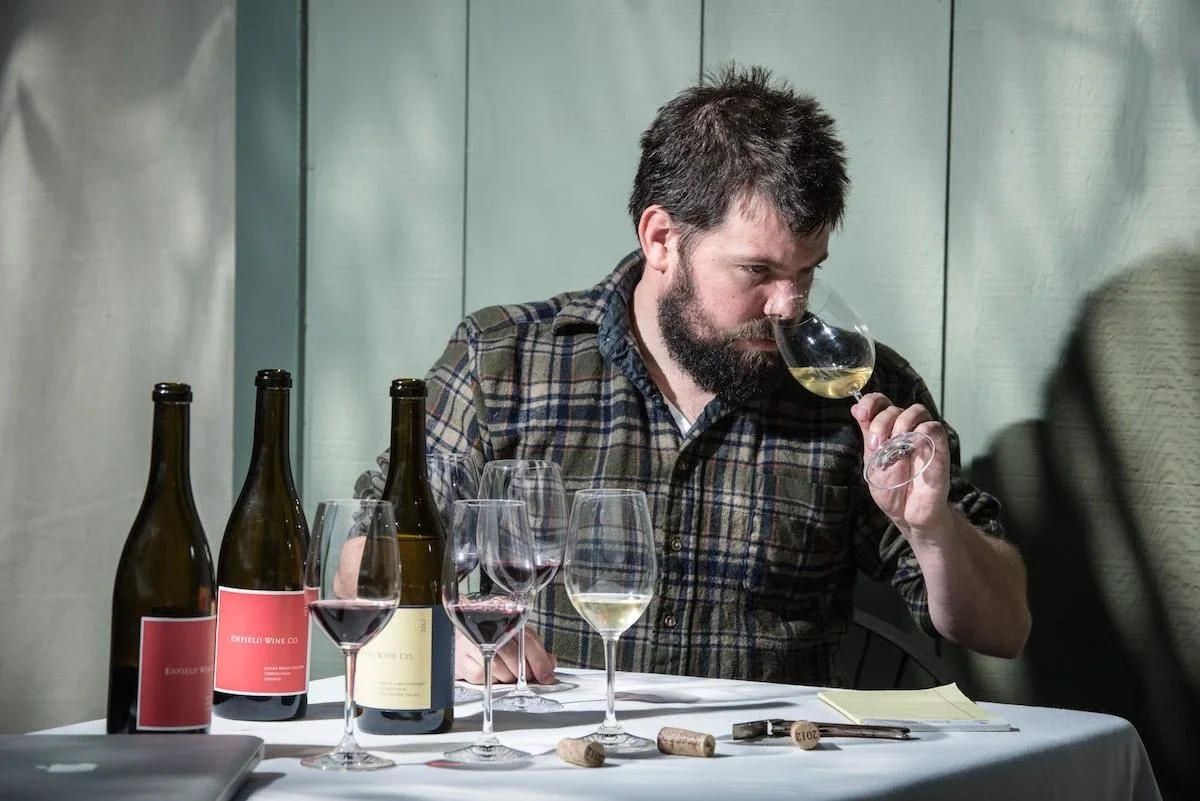New California Wines
The New California movement, as defined in Jon Bonne’s book “The New California Wine”, encompasses producers who are working with unusual varietals and making wines of balance and finesse that defy the traditional “new world-old world” divide. These are wines that have been inspired by the their old-world archetypes, yet with unique personalities unto themselves, and firmly rooted in the California terroir. And like their old-world brethren, they are crafted to work well at the dinner table.
John & Lucy Niven
CADRE BAND OF STONES GRUNER VELTLINER, EDNA VALLEY
Cadre is a collection of cool climate small production Albariño, Grüner Veltliner, and Sauvignon Blanc that is out to show the wine world the greatness of the lively, high acid, energetic and mineral driven cool climate white wines from the Edna Valley and the San Luis Obispo Coast. No one believes in white wines from the region more than John Niven does. He has been entrneched in the region or over 25 years and has deep roots in the Edna Valley with his grandfather Jack pioneering the first plantings in the valley in 1973.=
San Luis Obispo’s Edna Valley is truly a gem on an AVA for white wine varietals and deserves to be included in the broader conversation as one of the great white wine regions of the world. Its maritime influenced extreme cool-climate and diverse volcanic and oceanic soils allow the incredible opportunity to showcase aromatic white wines full of fruit filled with vibrant energy, salty minerality, and a whole lot of individual character. Freshness from the cool ocean balances out our California sunshine. Chardonnay has been the mothership since the region’s inception, but aromatic white wines are showing amazing promise!
NOTES FROM JOHN….
I spearheaded bringing New World Grüner Veltliner to prominence in the mid 2000’s when I convinced my family to plant 12.3 acres. These were the first Grüner plantings on the Pacific Coast and the first major plantings in California. Our neighbors thought we were crazy, but I had a hunch that an Edna Valley expression of Grüner Veltliner would turn some heads and indeed it has. One of our early Grüners (made under Zocker) ended up placing 4 th out of 60 wines at the Generation Grüner tasting held in four different cities in Europe (think of the Judgement of Paris ’76 but for Grüner). The Paragon Vineyard Grüner Veltliner vines lie in the direct path of the Pacific’s relentless cool fog driven winds. Day in and day out they are pushed to their limits of a long-drawn-out ripening process which ultimately delivers ripe fruit but preserves our vibrant acidity. The wine has a harmonious balance of ripeness, but a ton of verve and energy on the palate. A base of salty citrus, ginger and white pepper mingle with grapefruit that all lead to a savory zesty finish drenched in minerality. We added the Jack Ranch vineyard as a new addition to our sourcing for the Band of Stones back in the 2020 vintage. This is a tiny 1.5 acre block is located on the western edge of the AVA and is on a very steep Northwest slope that faces directly into the fierce cool winds funneling into the Edna Valley. This may very well be the steepest vineyard in the region. The soils are totally different than the Paragon Vineyard in that they are quite sandy. As a stand-alone wine there is a wonderful abundance of fruit, almost fruit cocktail like with exotic aromatics of orange blossom and Hawaiian fruits. In the final blend this site brings amazing aromatics that pair with classic white pepper and grapefruit. On the palate, it brings a fleshy roundness all while contributing amazing acidity. This site is super promising, and we can’t wait to see what it delivers in the many years to come!!
FOLLOW UP….ADDITIONAL INFORMATION:
1. When was the Grüner Veltliner planted? 2007
2. Where exactly is it grown? How many acres? Our Grüner is grown in the Paragon Vineyard Block 168 which is 8.3 acres. The block is made up of well drained soils with flecks of limestone and an underlying layer of residual material weathered from sandstone, shale, and mudstone. We also source Grüner from a newer vineyard named Jack Ranch. It's on the far west side of the Edna Valley, is only 1.5 acres but is on a steep sandy site facing Northwest (directly into the coastal winds).
3. How much Grüner is planted in California and the US overall? I can't speak to Oregon or the East Coast, but as of 2022 there were 155 acres planted in CA (per the USDA Grape Acreage Reports Listing). It wasn't until 2010 when the report shows Grüner under its own listing versus being lumped in the "Other White Varietals" category.
4. In John's experience, what are the hallmarks of Edna Valley Grüner vs. classic Austrian style? Is this Wachau inspired? The hallmark traits of Edna Valley Grüner are classic white pepper backed by a salty pithy citrus character. Our growing season is quite long. Often February into late October (this year we finished picking Grüner on November 1st!). For us it's all about slow and low. The San Luis Obispo Coast is the single coolests AVA in the state. Our summers are filled with fog and wind. Our high temps only last a few hours, right around noon...after the fog has burned off and before the cool winds kick in. The result is an extended growing season which ultimately allows us to get ripe fruit all while preserving loads of natural acidity. The ripeness of fruit and natural acidity allows us to get a balanced concentrated wine at a higher alcohol level that you would see in many Austrian Grüners. In theory, those levels would have our wine falling under the Smaragd classification.
5. What inspired the name Band of Stones? The wine has a sense of salty minerality that I love. Our region is also littered with a number of different soil profiles and is framed by 9 extinct volcanoes. Hence the name "Band of Stones."
6. Where was the plant material sourced from? Unfortunately I can't remember the vineyard name, but we sourced the budwood from a vineyard in Pennsylvania.
Anything else we can share with our guests? You can put a good chunk of the blame on the exploration of California Gruner on me 😀. My family thought I was crazy when I told them we needed to plan some. Our neighbors too, but I am sure glad we did. It's been super rewarding to see the excitement behind the varietal domestically. It has so much upside and is at the heart of my passion in starting Cadre and my quest to show the world how special of a white wine region the San Luis Obispo Coast is.
LISTEN TO JOHN ON THE WINE ENTHUSIAST PODCAST
Sam Bilbro from Idlewild Wines
IDLEWILD FLORA & FAUNA RED
Idlewild is a small winery based in Healdsburg, CA that produces Piedmontese varietals grown in the elevated hills of Mendocino County. It is owned and operated by Sam Bilbro, a fourth generation California winemaker. While Idlewild was founded in 2012, the true beginning was Sam’s childhood. His early years were spent walking vineyards and hanging out in a winery converted from an old cattle barn with his Dad (Chris Bilbro, Marietta Cellars). Like his Dad, Sam isn’t formally trained; instead, winemaking comes from taste, heart, and intuition. Memories of doing pump-overs while his Dad cooked dinner, of foraging porcini then sitting on a tailgate eating crusty bread and a pile of salami. These are the basis for Idlewild.
Idlewild's stable of wines includes three blends - The Bee White (Cortese, Arneis, Moscato Gialla), The Flower Rose (Barbera, Dolcetto and Nebbiolo), The Bird Red (Barbera, Dolcetto and Nebbiolo). And, single varietal wines made from Arneis, Cortese, Barbera, Dolcetto and Nebbiolo.
Idlewild sources fruit from just two vineyards (Fox Hill and Lost Hills Ranch). Both are managed by Wild Ruth Farming, a collaboration between Idlewild and Ruth Lewandoski Wines. Holistic farming ensures that the site and vintage are allowed to speak. Lost Hills Ranch is a dream. The beautiful loneliness of the open hills and the sentinel oaks covered in Spanish moss project out a sense of calm. The vineyard sits at 1500 ft of elevation, and the roots work hard to dig into fractured sandstone with schist veins and just a thin top layer of sandy clay. The Yorkville Highlands AVA sits along the southwest corner of Mendocino county and is marked by the clash of maritime and continental climates. Fox Hill Vineyard is one of the most unique vineyards in Northern California. Located southeast of Ukiah on Mendocino’s Talmage Bench, the soils are well drained with high concentrations of gravel, quartz, and sandstone. What makes this site so special is the fact that Lowell Stone decided to buck every trend and simply plant what he was interested in planting. Many trips to Italy turned to inspiration and the wild spectrum of varieties began to take root.
Flora and Fauna loosely means the collection of plant and animal life of a certain epoch. It is based on Barbera that is blended with Dolcetto, Freisa, Nebbiolo, and Grignolino to achieve the balance desired from this Piedmontese inspired blend. The fruit comes from Fox Hill Vineyard, Lost Hills Ranch, and Rancho Coda. Fox Hill lends depth, Lost Hills balances with vibrancy and bright aromatics, and Rancho Coda gives a core of fresh fruit and spice. In the end, Mendocino is on display with high and low tones and a very pleasant rusticity whileRussian River Valley fills in the gaps to make the wine cohesive.
John Lockwood of Enfield Wine
ENFIELD PRETTY HORSES RED
Winemaker John Lockwood was at the forefront of the New California movement. After spending 5 years at Failla, he left to start his own project. At Enfield, he would now have the freedom to create a range of wines that challenged the “old guard’. This elegant and playful wine is the definition of “greater than the sum of its parts.” The California blend combines Tempranillo, Grenache and a splash of Mourvedre. It takes inspiration from a traditional Spanish Temp or Rioja, but instead, is bright and juicy!
Enfield Wine Co. is the family project of John Lockwood and Amy Seese, with a focus on producing wines of personality. They do not subscribe to the ideal of the perfect wine, but to the notion that the very best wines tell a unique story.
Driven by soil first and foremost, Enfield Wine Co. seeks out vineyards that possess a distinct and powerful sense of place – across region, grape variety, and vine age. Working only with small vineyards and independent growers, every step of the process is guided by the intent to maximize this character of terroir. Grapes are harvested for balance and the wines are all given the chance to ferment naturally.
After surviving a summer job in high school hand-weeding grape vines at a winery in Vermont and studying as an apprentice to a Master Luthier (guitar builder) in Oakland, John got his start in the California wine industry in 2004 working up at Heron Lake vineyard with David Mahaffey. He went on to work harvests with Ted Lemon at Littorai, Bodega Melipal in Argentina, and Failla Wines with Ehren Jordan where he worked for 5 years farming and managing the Sonoma Coast and Russian River estate vineyards. He started Enfield Wine Co. in 2010 as small side-project while still working at Failla, and in 2013 took the plunge with Enfield as a full time project.





